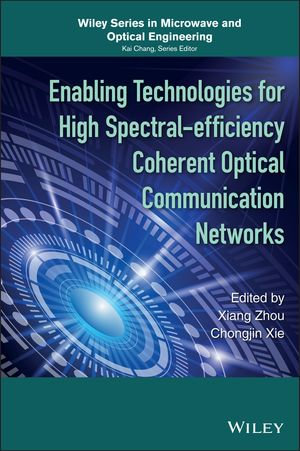
eTEXT
Enabling Technologies for High Spectral-efficiency Coherent Optical Communication Networks
By: Xiang Zhou, Chongjin Xie
eText | 29 April 2016 | Edition Number 1
At a Glance
eText
$255.19
Instant online reading in your Booktopia eTextbook Library *
Read online on
Not downloadable to your eReader or an app
Why choose an eTextbook?
Instant Access *
Purchase and read your book immediately
Read Aloud
Listen and follow along as Bookshelf reads to you
Study Tools
Built-in study tools like highlights and more
* eTextbooks are not downloadable to your eReader or an app and can be accessed via web browsers only. You must be connected to the internet and have no technical issues with your device or browser that could prevent the eTextbook from operating.
Presents the technological advancements that enable high spectral-efficiency and high-capacity fiber-optic communication systems and networks
This book examines key technology advances in high spectral-efficiency fiber-optic communication systems and networks, enabled by the use of coherent detection and digital signal processing (DSP). The first of this book's 16 chapters is a detailed introduction. Chapter 2 reviews the modulation formats, while Chapter 3 focuses on detection and error correction technologies for coherent optical communication systems. Chapters 4 and 5 are devoted to Nyquist-WDM and orthogonal frequency-division multiplexing (OFDM). In chapter 6, polarization and nonlinear impairments in coherent optical communication systems are discussed. The fiber nonlinear effects in a non-dispersion-managed system are covered in chapter 7. Chapter 8 describes linear impairment equalization and Chapter 9 discusses various nonlinear mitigation techniques. Signal synchronization is covered in Chapters 10 and 11. Chapter 12 describes the main constraints put on the DSP algorithms by the hardware structure. Chapter 13 addresses the fundamental concepts and recent progress of photonic integration. Optical performance monitoring and elastic optical network technology are the subjects of Chapters 14 and 15. Finally, Chapter 16 discusses spatial-division multiplexing and MIMO processing technology, a potential solution to solve the capacity limit of single-mode fibers.
? Contains basic theories and up-to-date technology advancements in each chapter
? Describes how capacity-approaching coding schemes based on low-density parity check (LDPC) and spatially coupled LDPC codes can be constructed by combining iterative demodulation and decoding
? Demonstrates that fiber nonlinearities can be accurately described by some analytical models, such as GN-EGN model
? Presents impairment equalization and mitigation techniques
Enabling Technologies for High Spectral-efficiency Coherent Optical Communication Networks is a reference for researchers, engineers, and graduate students.
Xiang Zhou is a Tech Lead within Google Platform Advanced Technology. Before joining Google, he was with AT&T Labs, conducting research on various aspects of optical transmission and photonics networking technologies. Dr. Zhou is an OSA fellow and an associate editor for Optics Express. He has extensive publications in the field of optical communications.
Chongjin Xie is a senior director at Ali Infrastructure Service, Alibaba Group. Before joining Alibaba Group, he was a Distinguished Member of Technical Staff at Bell Labs, Alcatel-Lucent. Dr. Xie is a fellow of OSA and senior member of IEEE. He is an associate editor of the Journal of Lightwave Technology and has served in various conference committees.
Read online on
ISBN: 9781119078258
ISBN-10: 1119078253
Series: Wiley Series in Microwave and Optical Engineering
Published: 29th April 2016
Format: ePUB
Language: English
Audience: Professional and Scholarly
Publisher: Wiley Global Research (STMS)
Country of Publication: US
Edition Number: 1











![Binaural Delta Waves : Harness The Power Of Low [2.8 Hz] Frequencies For The Deepest Sleep, Immediate Stress Relief, Inner Peace, And Total Mind-Body Rejuvenation - Purely Sounds Institute](https://www.booktopia.com.au/covers/200/9791223908273/4708/binaural-delta-waves.jpg)











